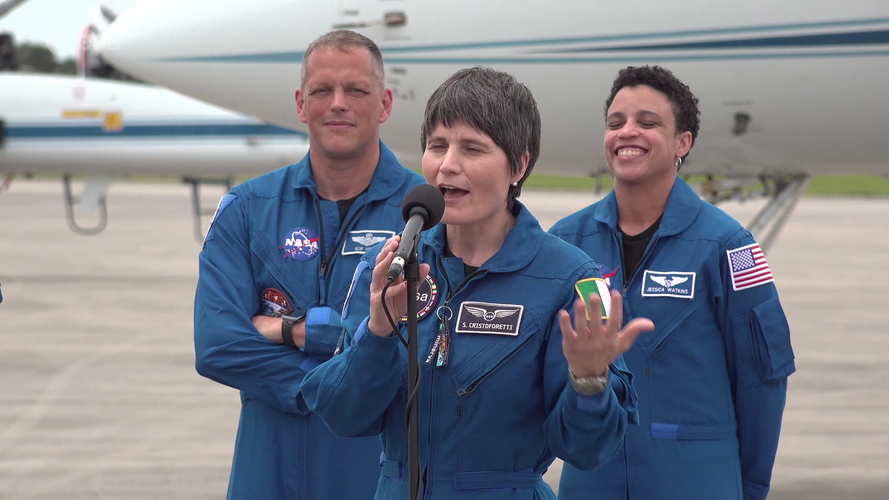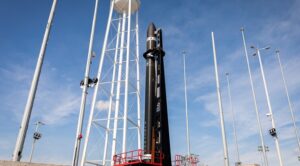Extraterrestrial mining would emulate 'tears of wine' phenomenon
Wednesday, 20 April 2022 11:26
Tears of wine is a phenomenon frequently observed as a ring of wine formed near the top of the glass generates droplets that fall back into the wine. This phenomenon can be explained by the Marangoni effect driven by the surface tension created via gradients on concentration and temperature along the interface between two phases.
In a paper published in Advances in Space Research, Jonathan Whitlow, an associate professor in biomedical and chemical engineering and sciences, and co-authors propose an extraterrestrial all-in-one mining process in which the Marangoni effect would allow non-mechanical transportation of the extraterrestrial mineral to feed an also in-situ pyrolysis-based refinery unit.
The researchers seek to establish that the Marangoni effect, which is crucial for welding metals, manufacturing integrated circuits and growing crystals, has the potential to be important for supporting lunar habitats and other extraterrestrial endeavors. They contend that vacuum and reduced gravity are expected to augment the Marangoni effect on extraterrestrial molten soil leading to sustainable extraterrestrial in-situ resources utilization.
Crew-4 arrive at Kennedy Space Center
Wednesday, 20 April 2022 11:00 Video:
00:06:28
Video:
00:06:28
ESA astronaut Samantha Cristoforetti arrives at NASA’s Kennedy Space Center in Florida, USA, with NASA astronauts Kjell Lindgren, Bob Hines and Jessica Watkins on 18 April 2022.
Collectively known as Crew-4, the astronauts flew in from Houston, Texas, and will spend the next week in quarantine before being launched to the International Space Station on a SpaceX Crew Dragon spacecraft.
When they arrive at the Station, Samantha’s Minerva mission will officially begin. This is the second long-duration space mission for Samantha who first flew to the orbital outpost in 2014 for her Italian Space Agency ASI-sponsored mission Futura.
Samantha will
Weather delays Ax-1 return
Wednesday, 20 April 2022 09:45
Poor weather will delay the return to Earth of four private astronauts from the International Space Station, which could in turn push back the launch of the next set of NASA and ESA astronauts to the station.
Rocket Lab to launch HawkEye 360 satellites on first Wallops Electron mission
Wednesday, 20 April 2022 09:02
The long-delayed first launch of a Rocket Lab Electron rocket from Virginia is now scheduled for late this year, carrying satellites for HawkEye 360.
The post Rocket Lab to launch HawkEye 360 satellites on first Wallops Electron mission appeared first on SpaceNews.
Op-ed | Space entrepreneurs need straight answers from DoD
Wednesday, 20 April 2022 09:00
Many space technologies developed by entrepreneurs haven't been allowed a proverbial seat at the table, says industry executive Charles Beames
The post Op-ed | Space entrepreneurs need straight answers from DoD appeared first on SpaceNews.
Weather satellite prepares for lightning
Wednesday, 20 April 2022 08:34
As one of the last milestones before liftoff at the end of the year, the first Meteosat Third Generation weather satellite is being fitted with its Lightning Imager. From geostationary orbit, 36 000 km above Earth’s surface, this state-of-the-art European instrument will continuously monitor lightning over more than 80% of Earth’s disc for early warnings of dangerous storms. Remarkably, it is capable of imaging relatively weak lightning events in full sunlight.
Kamala Harris announces U.S. ban on anti-satellite missile tests
Wednesday, 20 April 2022 07:32 Vice President Kamala Harris announced the United States' commitment to not conduct anti-satellite missile tests, making it the first country to institute the self-imposed ban against the destruction of orbitals that jeopardize the long-term sustainability of space.
"Simply put, these tests are dangerous and we will not conduct them," she said.
Harris announced the ban Monday night b
Vice President Kamala Harris announced the United States' commitment to not conduct anti-satellite missile tests, making it the first country to institute the self-imposed ban against the destruction of orbitals that jeopardize the long-term sustainability of space.
"Simply put, these tests are dangerous and we will not conduct them," she said.
Harris announced the ban Monday night b Glide Breaker Program Enters New Phase
Wednesday, 20 April 2022 07:32 DARPA is seeking innovative proposals to conduct wind tunnel and flight testing of jet interaction effects for Phase 2 of the Glide Breaker program. The overall goal of Glide Breaker is to advance the United States' ability to counter emerging hypersonic threats.
Phase 1 of the program focused on developing and demonstrating a divert and attitude control system (DACS) that enables a kill v
DARPA is seeking innovative proposals to conduct wind tunnel and flight testing of jet interaction effects for Phase 2 of the Glide Breaker program. The overall goal of Glide Breaker is to advance the United States' ability to counter emerging hypersonic threats.
Phase 1 of the program focused on developing and demonstrating a divert and attitude control system (DACS) that enables a kill v Abundant features on Europa bodes well for search for extraterrestrial life
Wednesday, 20 April 2022 07:32 Europa is a prime candidate for life in our solar system, and its deep saltwater ocean has captivated scientists for decades. But it's enclosed by an icy shell that could be miles to tens of miles thick, making sampling it a daunting prospect. Now, increasing evidence reveals the ice shell may be less of a barrier and more of a dynamic system - and site of potential habitability in its own right
Europa is a prime candidate for life in our solar system, and its deep saltwater ocean has captivated scientists for decades. But it's enclosed by an icy shell that could be miles to tens of miles thick, making sampling it a daunting prospect. Now, increasing evidence reveals the ice shell may be less of a barrier and more of a dynamic system - and site of potential habitability in its own right NASA's New Material Built to Withstand Extreme Conditions
Wednesday, 20 April 2022 07:32 NASA innovators recently developed a new metal alloy using a 3D printing process that dramatically improves the strength and durability of the components and parts used in aviation and space exploration, resulting in better and longer-lasting performance.
NASA Alloy GRX-810, an oxide dispersion strengthened (ODS) alloy, can endure temperatures over 2,000 degrees Fahrenheit, is more malleab
NASA innovators recently developed a new metal alloy using a 3D printing process that dramatically improves the strength and durability of the components and parts used in aviation and space exploration, resulting in better and longer-lasting performance.
NASA Alloy GRX-810, an oxide dispersion strengthened (ODS) alloy, can endure temperatures over 2,000 degrees Fahrenheit, is more malleab Scientists have improved the composition of radiation protection glasses
Wednesday, 20 April 2022 07:32 Scientists at the Ural Federal University (UrFU) with colleagues from the Arabian Peninsula have improved the radiation protection properties of glass, in particular borate glasses (boron oxide-based glass). They introduced special additives into the basic composition of the glass - heavy metal oxides. This significantly increased the density of the material without affecting its transparency. A
Scientists at the Ural Federal University (UrFU) with colleagues from the Arabian Peninsula have improved the radiation protection properties of glass, in particular borate glasses (boron oxide-based glass). They introduced special additives into the basic composition of the glass - heavy metal oxides. This significantly increased the density of the material without affecting its transparency. A Can LISA see the gravity waves 10 picoseconds after the Big Bang
Wednesday, 20 April 2022 03:01 The early universe may chirp about unknown physics. A University of Helsinki research team has demonstrated how an early universe phase transition will lead to gravitational wave signals potentially visible in the upcoming satellite missions. The research results were recently published in the prestigious journal Physical Review Letters.
Phase transitions, such as the boiling of water or t
The early universe may chirp about unknown physics. A University of Helsinki research team has demonstrated how an early universe phase transition will lead to gravitational wave signals potentially visible in the upcoming satellite missions. The research results were recently published in the prestigious journal Physical Review Letters.
Phase transitions, such as the boiling of water or t Axiom-1 return to Earth delayed due to weather
Wednesday, 20 April 2022 03:01 The Axiom-1 private astronauts aboard the International Space Station will stay in space a little longer because of poor weather in the area of the Atlantic Ocean where their capsule is to splash down.
Weather officials, together with Axiom, NASA and SpaceX, are working to determine when they can safely bring the crew home. The crew has already spent 12 days in space.
Once a new
The Axiom-1 private astronauts aboard the International Space Station will stay in space a little longer because of poor weather in the area of the Atlantic Ocean where their capsule is to splash down.
Weather officials, together with Axiom, NASA and SpaceX, are working to determine when they can safely bring the crew home. The crew has already spent 12 days in space.
Once a new Rocket Lab secures multi-launch contract with HawkEye 360
Wednesday, 20 April 2022 03:01 Rocket Lab (Nasdaq: RKLB) has been selected by Virginia-based HawkEye 360 to launch three Electron missions for the radio frequency geospatial analytics provider. The first of the three missions is scheduled to be Rocket Lab's inaugural Electron mission from Launch Complex 2 on Wallops Island, Virginia, ushering in an era of Rocket Lab launches from U.S. soil from no earlier than December 2022.
Rocket Lab (Nasdaq: RKLB) has been selected by Virginia-based HawkEye 360 to launch three Electron missions for the radio frequency geospatial analytics provider. The first of the three missions is scheduled to be Rocket Lab's inaugural Electron mission from Launch Complex 2 on Wallops Island, Virginia, ushering in an era of Rocket Lab launches from U.S. soil from no earlier than December 2022. NASA builds welding test article for SLS Exploration Upper Stage
Wednesday, 20 April 2022 03:01 NASA completed manufacturing of a hydrogen tank barrel that will be tested as a weld confidence article for the Space Launch System (SLS) rocket's Exploration Upper Stage (EUS). Weld confidence articles help establish welding procedures and interfaces between the tooling and hardware and ensure the structural integrity of the welds. Starting with the Artemis IV mission, the EUS will provide the
NASA completed manufacturing of a hydrogen tank barrel that will be tested as a weld confidence article for the Space Launch System (SLS) rocket's Exploration Upper Stage (EUS). Weld confidence articles help establish welding procedures and interfaces between the tooling and hardware and ensure the structural integrity of the welds. Starting with the Artemis IV mission, the EUS will provide the 
